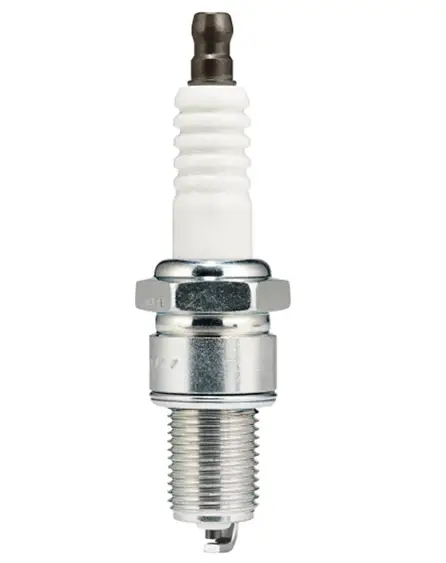ATV spark plugs are one of the most important parts of an ATV engine. They also need inspecting and changing periodically. So, today I’ll explain how long a typical ATV spark plug will last.
Generally, 6 to 12 months. ATV owner’s manuals for the most popular ATV brands say that they should be inspected and replaced when necessary every 6 months. But, there are signs that you can hear from the engine that indicate the spark plugs need to be replaced sooner.
In this article, I will explain what a worn spark plug looks like, as well as signs that the spark plug has failed and needs to be replaced.

How To Tell If Your ATV Spark Plug Is Bad
The sound of the engine can give a very clear indication that one or more of the spark plugs is bad. As well as changes in fuel consumption and acceleration. I’ll first explain the signs that one or more of the spark plugs are faulty, need to be adjusted or cleaned. And then after that explain exactly what to do in each case.
The main symptoms of bad spark plugs are:
- The engine backfires
- Idling vibration and noise is not constant
- The fuel consumption seems to have gone up – it uses more fuel
- It doesn’t accelerate as well as it has in the past
- It takes longer to start when you turn the ignition
- The color on the tip of the spark plug is not off-white to tan in color
1. The engine backfires
If the engine backfires at all, it generally indicates the spark plugs are bad and should be inspected. This occurs because the spark plug is not creating a spark to ignite the fuel. Excess fuel then builds up and explodes all at once creating a backfire, according to NGK one of the leading manufacturers of spark plugs.

2. Idling the noise of the engine is not constant
Once the engine is fully warmed up, the engine should produce a constant hum. If you notice it stops and starts a bit then, it’s likely the spark plugs are misfiring due to the electrode on the end being worn or covered in soot. The gap can also need to be adjusted on the tip of the spark plug.
3. You notice it consumes more fuel than normal
If you notice that you’re filling up your ATV more often even though you’re using about the same amount it generally indicates an issue with a spark plug. When the spark plug isn’t sparking and igniting the fuel, fuel gets wasted and sits on the engine, and evaporates.
4. Reduced ability to accelerate
Once you’ve ridden your ATV for a while you will have a feel for how fast you can go in each gear. And how it feels when you accelerate. If you notice your ATV doesn’t accelerate as well then a spark plug may be misfiring or not firing at all.
As the spark ignites the fuel it turns the pistons, which directly lead to turning the wheels.

5. Takes longer to start – can be the starter motor but also spark plugs
When one or more of the spark plugs is not sparking constantly or isn’t firing at all, the engine can take longer to turn over when you turn the ignition one. This can also indicate a faulty starter motor.
6. The color on the tip of the spark plug is not light brown to off-white
The tip of the spark plug – about the top half-inch should have an off-white to tan color to it. It shouldn’t be completely white or and darker as it indicates that there is an issue with the spark plug. Or the engine itself.
Here’s a really good video that shows how a spark plug should look, and what it means based on the color and wear on the spark plug.
What maintenance you should do on an ATV spark plug
As an ATV spark plug is used it can develop corrosion, this is evident where a rust-like color is visible on the end of the electrode. Also, soot and dust can accumulate on the spark plug and interfere with the electrode. It can be cleaned off.
Spark plugs can come pre-gapped but others need to be gapped manually. This can be done using a small tool you can pick up at car accessories stores like Autozone. The owner’s manual for your ATV will explain the correct gap distance for the spark plugs on your specific ATV.
When inspecting the spark plugs every 6 months it’s also recommended in the owner’s manuals of most ATVs to check the gap of the spark plug, as it can have changed since when it was first installed.
Where Is the Spark Plug on an ATV Located?
If you’re never changed the spark plugs on an ATV it can be difficult to locate them. So, I thought I’d explain where they’re located. It can differ by make and model but here’s where they are on most ATVs.
ATV spark plugs are generally located on the side of the engine and there is a black cable with a cover on top that needs to be removed to access the spark plug. Also, it can be in a position where you need to first remove a cover to gain access to the part of the engine where it is located.
The owner’s manual for ATVs almost always shows a diagram of where the spark plugs are located. The top ATV brands provide copies of the ATV manuals online on their website. However, older user manuals can be more difficult to find but a Google search can generally bring them up.
The cable that houses the spark plug on an ATV looks the same on virtually all engines. So, once you know what it looks like it should be easy to locate. Here’s a good video that shows what it looks like.
How Many Spark Plugs Does an ATV/Four Wheeler Have?
An ATV and a four-wheeler engine are slightly different from other vehicles. So, you may be curious how many spark plugs an ATV, four-wheeler, or quad has. Based on my research here’s what I found.
On average, ATVs have 1 spark plug. The same is also true of four-wheelers, and quads. It’s generally accessible from the side of the engine by pulling out the spark plug connector which is a black hose that runs from the battery to the engine.
The spark plugs are screwed into the engine and need to be loosened with a socket. Once it’s a bit loose you can unscrew the rest with your hand. But, be very careful if you’ve recently ridden your ATV as the engine can be extremely hot.
